You’ve done the hard work and your garden is looking better than ever – but there’s just one thing missing and you can’t seem to put your finger on it.
How about edging your lawn? Lawn edging is the equivalent of icing a cake, or perhaps, the cherry on top of an ice cream sundae!
I found the best garden edging ideas to level up your outdoor space, from using flower beds to plain garden beds and so much more. Keep reading to find out more about these amazing lawn edging ideas that will help you put the perfect finishing touch to your garden.
Contents
- 1 Lawn And Garden Edging
- 1.1 Picture Perfect Pebbled Lawn Edging
- 1.2 Pebbled Edging With A Twist – Plants!
- 1.3 Pebbles Alongside Curved Tiled Edges
- 1.4 Steppers With Pebbles
- 1.5 Stepping Stone Side Path
- 1.6 Versatile Old Tiles
- 1.7 Pound-In Edging
- 1.8 Metal Lawn Edging
- 1.9 Rubber Flexi Border
- 1.10 Edging With A Mulch Garden Bed
- 1.11 Using Wood
- 1.12 Vertical Wood Planks
- 1.13 Go Green
- 1.14 Reduce, Reuse, Recycle!
- 1.15 Concrete Elevated Planters
- 1.16 Brick And Stone Side Planters
- 1.17 Wood Side Planters
- 1.18 Corner Seats
- 1.19 Raised Patio
- 1.20 Sparkly Night Lights
- 2 FAQs
- 3 Which One Of These Lawn Edging Ideas Is Your Favourite?
- 4 About The Author
Lawn And Garden Edging
Picture Perfect Pebbled Lawn Edging
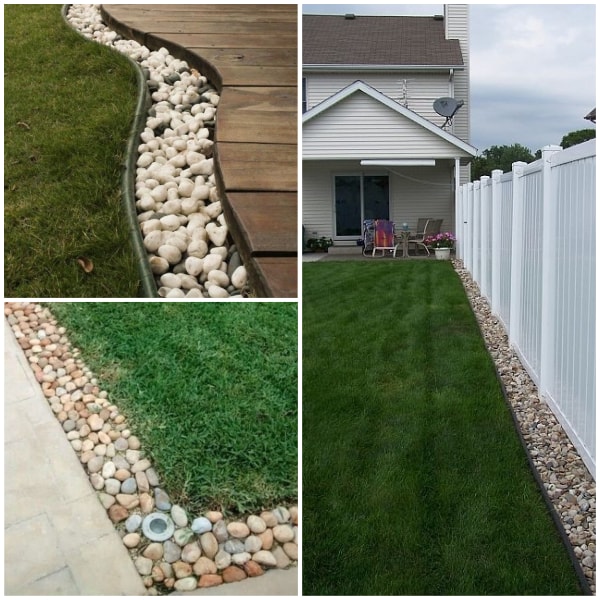
The use of pebbles in your garden is a great way to transition from your porch area to your lawn. Simple yet attractive, I believe that pebbles are the perfect option to add a finishing touch to your lawn edging idea.
Little loose pebbles can become a bit messy if they aren’t set correctly – it’ll definitely be worth your while to follow the correct procedure when laying them out for the first time to avoid any future untidiness.
To keep them in order, you can lay out a plastic sheet between your lawn and pebbles, creating a form of garden bed. This will keep them in place at all times, keeping your lawn looking pristine!
| Pros | Cons |
| Attractive transition from the porch to the lawn | Can become messy if not implemented correctly |
| Simple, versatile design |
Pebbled Edging With A Twist – Plants!

If you thought plain old pebbles were great, you’re in for a shocker with this pebble and plant combo. I think that these make for the prettiest garden edging ideas and are sure to make your garden space stand out from the rest.
Since you won’t walk on the pebble area, you can use a smaller version of the pebble, says Christopher FeDeo, our landscaping stone expert.
Laying pebbles around your plants will actually help them live longer, according to Garden For Indoor, an expert garden-related website owned by Arifur Rahman, a plant specialist. This is because the pebbles can prevent the soil from getting eroded by rain or damaged by over-exposure to the sun. In addition, pebbles will also prevent weeds from growing and improve water drainage.
A garden edging option that’s both pretty and functional? A major win in my opinion!
| Pros | Cons |
| Makes the garden stand out | May require additional maintenance for plants |
| Improves water drainage and weed prevention |
Pebbles Alongside Curved Tiled Edges

This method takes a little more planning and designing to perfect, but I can assure you that the results are worth it. Before getting out your shovel and edger, it’s recommended that you use pegs and string to mark out your desired route. This will make the process a lot easier when you actually get into it.
What’s great about curved edges is that they’re elegant, polished and can very easily blend in with your garden. The addition of pebbles makes this one of the most aesthetically pleasing garden edging ideas.
P.S. If you’re on the fence about edgers and trimmers and want to know what the actual difference is between these tools, take a look at this detailed description and comparison guide to help you out!
| Pros | Cons |
| Elegant, polished design | Requires more planning |
| Easily blends with garden | May be more challenging to install |
Steppers With Pebbles

Looking for an easy-to-maintain option that still gives you beautiful results? I think that adding steppers lined with small pebbles is the perfect option for you.
While there are probably thousands of stepper path variants to choose from, they all have a couple of things in common: they work well with light to moderate foot traffic, they can be customized to your personal preference no matter what that may look like, and they don’t require much maintenance at all.
If you’re into a natural look, organic stepping stones (typically round-shaped) will suit you best. If you prefer a more pristine and polished look, rectangular stepping stones are your best bet.
| Pros | Cons |
| Easy to maintain | May not withstand heavy foot traffic |
| Customizable to personal preference |
Stepping Stone Side Path
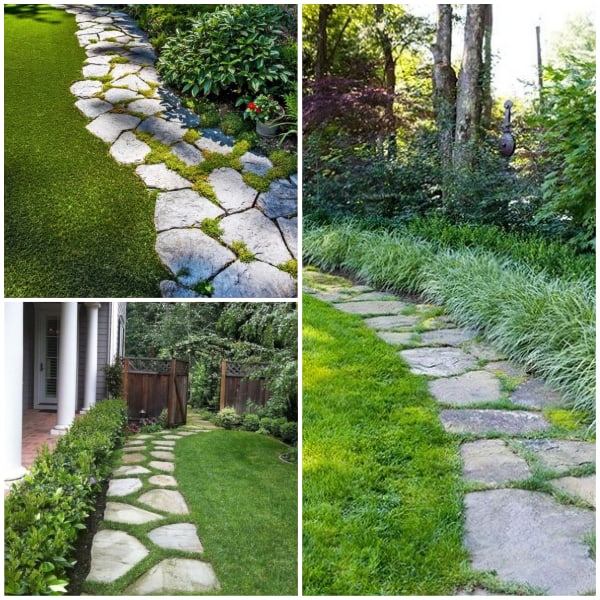
This is one of the most natural-looking options that is also very easy to lay. You can achieve this rustic look without breaking the bank (or your back, for that matter!)
A stepping stone side path is great if you would like to add texture and visual interest. I think it also goes without saying that this is a preferred option if you’d rather not have your lawn trampled on.
If you’re a DIYer who’s planned carefully, building your own stepping stone side path could take you as little as a day to complete. For example, one of my friends tried it and even though she isn’t the best DIYer, it took her just over a couple of days, which was surprising, to say the least.
The most important thing I want to note if you’re considering this option is that the ideal stepping stones should be flat and 18 inches across and 2 inches thick, according to Family Handyman, a leading DIY magazine and resource for home improvement projects.
Have a look at this article for similar sidewalk ideas!
| Pros | Cons |
| Natural-looking, rustic design | Requires careful stone selection |
| Budget-friendly | |
| Protects lawn from foot traffic |
Versatile Old Tiles

Do you have piles of tiles taking up space in your shed and you just don’t know what to do with them? How about using them to edge your lawn? I’m quite impressed with just how versatile tiles are, to be honest!
Whether you have plain old clay roof tiles or fancy marble ones, they can all be repurposed to edge your lawn. The process may be a little more complicated if you’re going with a more elaborate look rather than a simple, rustic one. But the options are pretty much endless with tiles. I highly suggest you edge out a garden bed with these since it’ll look really nice and elegant.
| Pros | Cons |
| Repurposes unused tiles | Potentially more complex installation |
| Highly versatile design options |
Pound-In Edging
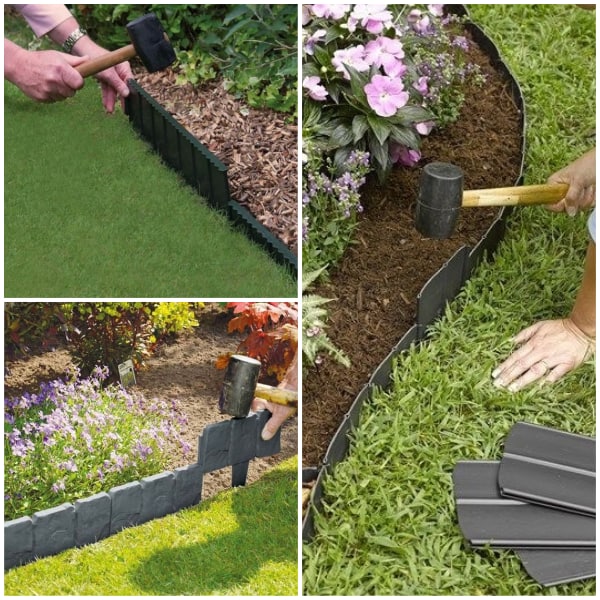
Say goodbye to conventional lawn edging! Pound-in edging, also known as the easiest and quickest lawn edging option, is taking the landscaping world by storm.
Lauded to create a well-defined landscape border in just a matter of minutes, these garden edging sections can form curves or angles, circle trees, or border gardens and flower beds. Can it get any better than this?
Curious about how to install these? Well, there’s no need for digging trenches, laying it in or backfilling. All you need is a rubber mallet to simply tap the interlocking pieces into place. These sections are generally made of heavy-duty plastic (so they’re quite durable but still flexible) and have a serrated-tooth design, which I can safely say makes it all the easier to install.
| Pros | Cons |
| Easy and quick installation | May not be as visually appealing as other options |
| Versatile in forming curves or angles | Not eco-friendly because of the use of plastic |
| Durable, heavy-duty plastic |
Metal Lawn Edging

Metal lawn edging basically has the same properties as pound-in plastic edging – the only difference is that it’s made out of metal and is more expensive than plastic edging. The most common materials used to make these are steel and aluminum. Keep in mind that opting for a steel garden edging option could be troublesome in the long run because they’ll rust.
Metal edging is quite popular and very easy to install because it generally comes in straight, 20-foot sections. Recommended by professional landscapers, metal garden edging lasts extremely long as it won’t rot, crack, chip, or become worn due to weather conditions, so I’m pretty sure that you won’t have to stress about maintaining it.
| Pros | Cons |
| Durable and long-lasting | Steel edging may rust over time |
| Easy to install | |
| Resistant to weather conditions | |
| Eco-friendly |
Rubber Flexi Border

A rubber edging flexi border is generally made from recycled rubber. It’s quite popular because it’s weatherproof and eco-friendly. Supplied with color-coded rubber pins, rubber edging flexi borders are easy to install, and if installed correctly, I can safely say that it’ll last you approximately 20 years.
Due to its flexibility, it can be used to create a curved garden bed, pathways and lots of other garden features. Its lawnmower-friendly design allows you to cut your lawn right up to the garden edge without any damage and it’s also great if you have kids or pets in the yard because it has soft edges.
| Pros | Cons |
| Versatile | Rubber may degrade over time |
| Easy to install | |
| Lawnmower, kid, and pet-friendly |
Edging With A Mulch Garden Bed

Mulch flower beds can really be leveled up with a little bit of garden edging. Similar to raised flower beds, mulch garden beds retain moisture in the soil, suppress weeds and keep the soil cool. There are plenty of methods to choose from, such as digging an unlined trench, using metal/plastic edging material, installing bricks/concrete pavers and creating raised stone borders.
I also suggest you have a look at this round-up of landscaping ideas with mulch and rocks for your backyard for some more mulch-inspired garden edging ideas!
| Pros | Cons |
| Retains soil moisture | Maybe less visually appealing than other options |
| Suppresses weeds | |
| Keeps soil cool |
Using Wood

I was honestly a bit skeptical about the idea of using wood to edge lawns when I first heard about it. My first impression was that wood wouldn’t have much to offer in terms of aesthetics and it would limit your options because it isn’t exactly pliable.
But now that I’ve done a bit more research, all I can say is wow!
If you’re looking for a cost-effective option that gives your garden a rustic look, using wood to edge your lawn could be the perfect choice for you. The materials needed for this are relatively cheap and it’s also very quick to install.
If you’re thinking, “But I still can’t use it to curve my walkway or garden edge”, you actually can! This can be done by using pliable bender boards.
If this is an idea you’d like to try out, I think that it’s worth pressure-treating your wood to avoid any premature rot when it’s made contact with the ground. Alternatively, you can use redwood or cedar because they don’t rot as easily.
| Pros | Cons |
| Cost-effective option | Wood may be susceptible to rot |
| Rustic Aesthetic | |
| Quick installation | |
| Eco-friendly |
Vertical Wood Planks

This look is simple yet sophisticated. If you stagger the planks a little so that they’re different heights, you can achieve a neat and tidy edge.
Keep in mind that when you’re using wood in your garden to edge or create structures, I always suggest you use redwood or cedar. These wood types are great because they’re weather resistant and will last longer than others.
If you’re still on the fence about using additional edging tools and materials to edge your lawn, check out this article on how you can edge your lawn, even if you don’t have an edger.
| Pros | Cons |
| Neat and tidy appearance | May require additional tools or materials |
| Weather-resistant if using redwood or cedar | |
| Eco-friendly |
Go Green

Edging your lawn with some more greenery? Yes, please! Using box-shaped hedges to edge your lawn gives you a beautiful end result. They are a little higher maintenance than other garden edging ideas because you’ll have to trim and shape them regularly to keep their shape. But if you don’t mind putting in that extra hour or two every couple of weeks, this is a great option!
The key to nailing this idea is the type of shrub you plant because you will need something low growing that gives you a wide shape to work with easily.
After trying some of these ideas out, I’ve found that plants like ilex (holly) hedges, Spekboom and false heather are great options. Not only do they work well to edge your lawn, but some of them also flower, adding to your yard’s aesthetics.
If you’re looking for more ideas on how to give your lawn a little pick me up, check out this article about lawn striping.
| Pros | Cons |
| Adds extra greenery | Higher maintenance for trimming |
| Visually appealing and versatile | |
| Some plants may flower for added beauty |
Reduce, Reuse, Recycle!
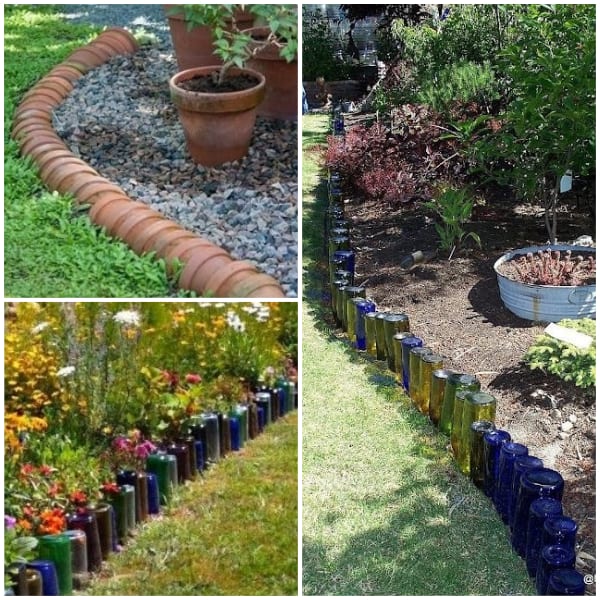
Did you know that you can edge your lawn with glass bottles, broken ceramic pots, and old crockery? Before splurging on any edging material, have a look around your yard and home for any material lying around that you could repurpose for your edges.
The options are endless! I’ve seen some of the most beautifully edged lawns that used recycled items such as colorful glass bottles and even vertical dining plates set into the ground in a line, showcasing their pretty patterns.
It’s never a bad idea to go green and if you’re looking to adopt more environmentally-friendly garden practices, this option will be perfect for you! In my opinion, nothing looks better than a garden bed edged by recycled flower pots.
| Pros | Cons |
| Environmentally friendly | Durability of materials may vary |
| Repurposes unused items | |
| Unique, creative aesthetic |
Concrete Elevated Planters

If you’re willing to get your hands a little dirty and have some time to invest to get a pristine-looking edged lawn that will pretty much never require any maintenance, this is the one! Elevated planters are gorgeous and will really improve your garden’s visual interest.
Edging your lawn with concrete elevated planters will require you to dig trenches, set concrete blocks, and backfill them, among many other steps. It will take some time, but once you see the results, I can assure you that you won’t regret it!
| Pros | Cons |
| Pristine, low-maintenance edging | Time-consuming and costly installation |
| Enhances visual interest |
Brick And Stone Side Planters

I think that using brick and stone side planters to edge your lawn will give you a similar effect to concrete elevated planters. They’re also extremely weatherproof and will last you a very long time without needing much maintenance.
This idea takes a bit of time and requires careful planning. You will need to dig trenches, mix concrete, and lay each brick or stone carefully to get a leveled, pristine result.
Brick and stone side planters are also great if you have plants that have different needs in terms of soil conditions, compared to the rest of the plants in your garden.
| Pros | Cons |
| Low maintenance | Time-consuming and costly installation |
| Accommodates plants with different soil needs |
Wood Side Planters
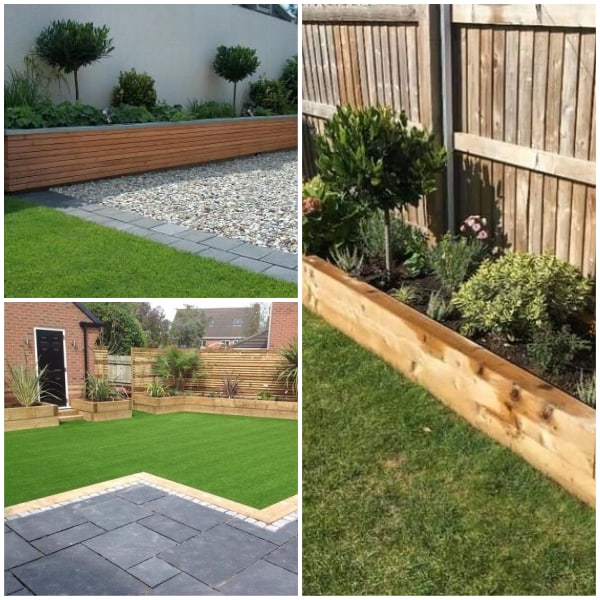
Woodside planters are best suited for gardens with square geometry. They’re also quite durable and will last quite long if you use the right type of wood (such as cedar or redwood, as I mentioned above).
If you’re considering trying out these planters, be sure to research your drainage options so that they don’t get ruined when you tend to your plants. I also suggest you raise your planter a little to encourage drainage.
| Pros | Cons |
| Neat design | Requires careful drainage planning |
| Durable with the right wood choice | |
| Eco-friendly |
Corner Seats
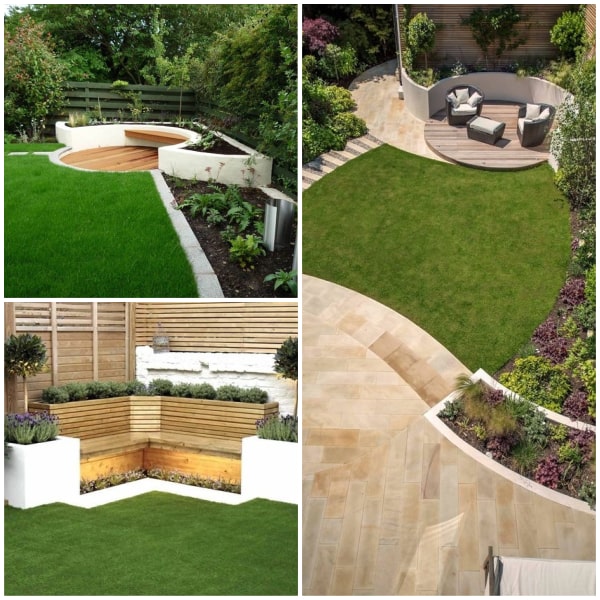
The combination of plants and corner seating is such a wonderful concept that delivers great results no matter how you choose to style and design them. They’re sophisticated and blend into your yard seamlessly.
If this idea piques your interest, bear in mind that this is the type of project that you’ll need to hire expert help for if you’re not a professional or used to complicated garden practices.
If you’re trying to make the most out of a smaller garden space, this idea would be perfect for you. This one definitely ranks in my top 5 of the best lawn edging ideas!
| Pros | Cons |
| Sophisticated and appealing design | Complex and expensive |
| Adds value to your property | |
| Great for smaller garden areas | |
| Multi-functional |
Raised Patio

A raised patio is an extensive undertaking that requires the help of a professional. It can be quite expensive and will need some time to complete. I could probably make a couple of raised garden beds in the meantime.
Building a raised patio involves digging a trench, leveling the bottom, making it damp and waterproof, building a retaining wall, and preparing the base of the patio, according to Allan Block, a leading hardscaping corporation and wall system manufacturer.
But the results are outstanding and definitely worth it in my opinion! You just need to have the budget for it and be prepared to wait it out.
| Pros | Cons |
| Sophisticated and appealing design | Expensive and time-consuming project |
| Adds value to your property |
Sparkly Night Lights

If aesthetics are as important to you as achieving pristine edges in your outdoor space, I think that going for one of the garden edging ideas with night lights would be great. These night lights basically line the garden edge. You can use outdoor rope LED strip lights to achieve this sparkly look.
Many of these roped night lights come with adhesive strips so they’re pretty easy to install. All you’ll need to do is make sure they’re stuck against your edging frame or paving.
| Pros | Cons |
| Enhances aesthetics of your lawn | May require regular maintenance |
| Easy to install with adhesive strips | |
| Adds safety and visibility at night |
FAQs
How often should you edge your lawn?
You should edge your lawn at least once a year. There are a number of factors to take into consideration, though, such as the type of grass you have, the time of year, and your region’s weather conditions, as there isn’t a hard and fast rule.
Does lawn need edging?
Lawns do not need edging. Edging your lawn isn’t a requirement to making it healthy-looking and it can still look well-maintained without edging. The process just tidies it up, helping you achieve a more pristine look and distinct shape in your yard.
What can I use for landscape edging?
You can use stone, concrete, brick, wood, tiles, metal and logs for landscape edging. These are just the most commonly used materials, though, and there are a lot more, including recyclable ones. The materials you can use all come down to what look you aim to achieve.
What is the point of an edger?
An edger is used on lawns to create distinct boundary lines and to separate areas of your yard. It’s a great tool to use to remove weeds and trim overgrown grass that creeps onto sidewalks, patios, or driveways. An edger can help you achieve a pristine garden.
Which One Of These Lawn Edging Ideas Is Your Favourite?
Lawn edging is not just a gardening practice – it’s also a great way for you to express your creativity in your outdoor space. I hope my list of lawn edging ideas helped you find something you’d love to try out in your own yard.
If you’ve yet to decide what material to use for your garden edge, I suggest you check out some of the best edging materials, according to Bricks+Agent, a property maintenance and management platform.
What did you think about these ideas? Please leave a comment below – I’d love to hear your thoughts! If you liked these ideas, please feel free to share so we can spread the lawn edging love!